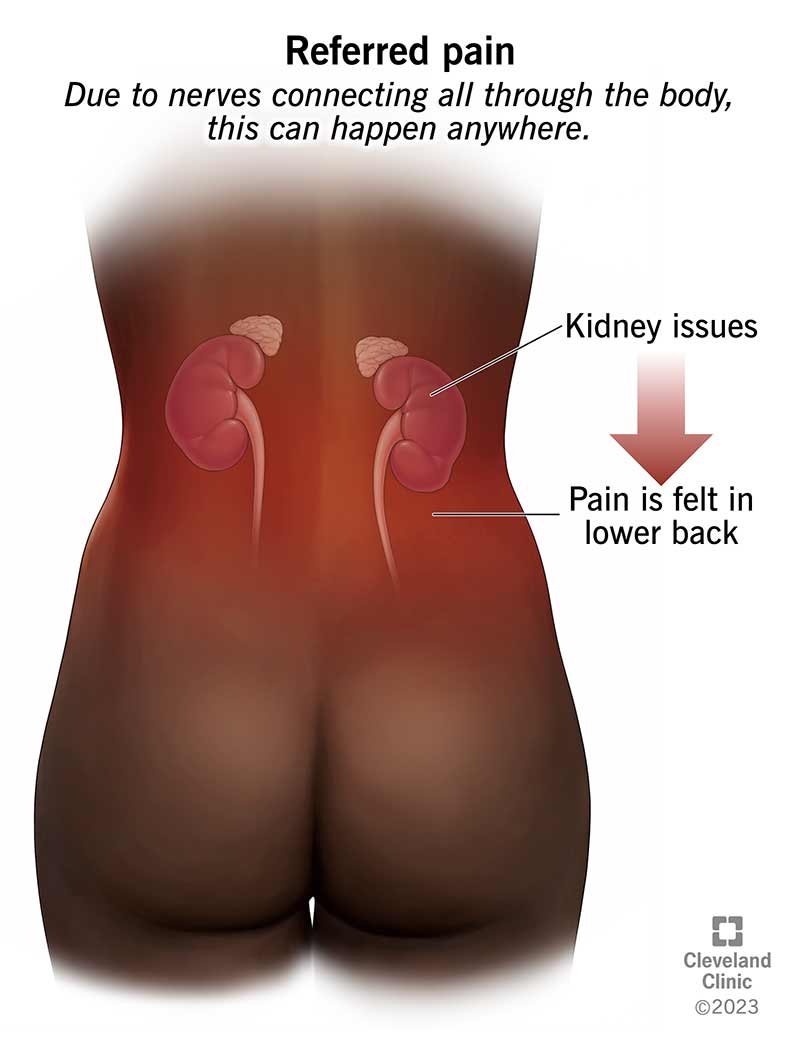Referred pain is when you have an injury in one area of your body but feel pain somewhere else. This happens because all the nerves in your body are part of a huge, connected network. Referred pain can occur anywhere, but it’s most common in your neck, shoulders, back, teeth and jaws.
Advertisement
Cleveland Clinic is a non-profit academic medical center. Advertising on our site helps support our mission. We do not endorse non-Cleveland Clinic products or services. Policy

Referred pain is when you feel pain in one part of your body, but the real source of that pain is coming from somewhere else. One common (and harmless) example is brain freeze. The extreme cold touches your mouth and throat, but you feel the effects of it in your head.
Advertisement
Cleveland Clinic is a non-profit academic medical center. Advertising on our site helps support our mission. We do not endorse non-Cleveland Clinic products or services. Policy
Sometimes, referred pain indicates serious underlying health conditions. It’s important to know why it happens and what you should look for.
There are several different types of referred pain. You might have pain that’s:
Many people describe referred pain as expanding pressure. As the pain sensation spreads, it can be more difficult to pinpoint to a particular area.
It’s not always easy to tell the difference between typical pain and referred pain. But if you develop pain in an area where you didn’t have an injury, you should call a healthcare provider. For example, it’s normal to develop pain in your shoulder after you pull a shoulder muscle. But if you have sudden shoulder pain for no apparent reason, it’s probably referred pain. Maybe the pain is really coming from your belly, and your body is trying to tell you something.
If you have back or shoulder pain and you’re also having trouble breathing, dizziness or chest pain without an injury in those areas, speak to a healthcare provider right away. Pain in these areas might be symptoms of a heart attack or another heart condition.
There’s a connection between every nerve in your body. That’s why referred pain happens. When you encounter certain stimuli, your nervous system sends signals to your brain. In turn, your brain sends warning signals to your body that say, “Danger! Pain!”
Advertisement
But sometimes your nerves are like crossed wires. Even though the pain stimulus affects one area of your body, your brain might send pain signals to another area instead.
There are certain areas of your body that are more prone to referred pain. In fact, these reactions are so common that healthcare providers often consider them symptoms of health conditions in other parts of your body.
Some of the most common examples of referred pain include:
These are just a few examples. Referred pain can occur in any area of your body, and it might indicate a wide range of health conditions. To find out what your pain is trying to tell you, schedule an appointment with a healthcare provider.
Your healthcare provider will start with a physical examination. They’ll also ask questions about your pain symptoms. Questions they might ask include:
To confirm a diagnosis or rule out certain health conditions, your provider may recommend additional tests. These tests may include:
To treat referred pain, you must treat the underlying condition. If you address the painful area instead of the injured area, you probably won’t get results.
Treatment depends entirely on any underlying health conditions. For instance, if fibromyalgia causes referred arm pain, then a healthcare provider will treat the fibromyalgia. This should take care of the arm pain.
If you still have referred pain even after you treat the underlying condition, your healthcare provider might recommend ways to ease your discomfort. Possible referred pain treatments include:
Advertisement
There are ways to soothe pain and reduce inflammation at home. But before trying these techniques, be sure to talk to a healthcare provider. They’ll need to rule out any serious health concerns like a heart attack or organ damage.
Home remedies for pain include:
If you’re experiencing pain that you can’t explain, you should talk to a healthcare provider immediately. Referred pain is your body’s way of crying out for help.
You should call 911 or head to your nearest emergency room if you have heart attack symptoms like referred shoulder, arm, teeth or jaw pain.
While referred pain and phantom pain are similar, they’re two different symptoms. Phantom pain is when you feel pain in a missing part of your body. (Phantom limb pain is the most common example.) Referred pain involves two existing body parts.
Advertisement
It can be confusing when we experience referred pain. When an uninjured part of our body starts hurting, it doesn’t always make sense. But referred pain might mean you have something else going on. If you recently developed pain and don’t know why, schedule an appointment with a healthcare provider. They can help determine if you have another health condition that needs treatment.
Advertisement
Last reviewed on 09/11/2023.
Learn more about the Health Library and our editorial process.